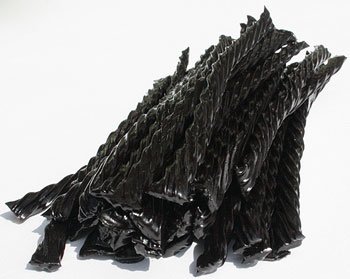 Liquorice
Liquorice© Denzil Green
Most people either love liquorice or hate it. Fewer are the people who are neutral about the taste.
Liquorice is the root of a perennial shrub that above ground grows up to 3 feet tall (1 metre.) The leaves are feathery, and it produces light violet-blue flowers. The tap root grows down as far as 3 feet (1 metre); from it, rhizome “roots” can spread out underground up to 20 feet (6 metres.) The bark of the root is even sweeter than the inside of the root.
The plants need to be let grow for 3 to 4 years before harvesting. Both the tap root and the rhizomes are harvested. When freshly harvested, the root is a yellowish-brown. The roots are dried, then crushed, boiled and pressed. The process concentrates the juices and extracts a thick black syrup that looks like treacle, which is pure “liquorice.”
Liquorice is one of the few spices that actually are sweet on their own. Liquorice root contains about 4% glycyrrhizin acid, glycyrrhizin being 50 times sweeter than sucrose, which is what’s in cane sugar (some researchers have suggested it may actually be up to 150 times sweeter than sugar.)
Most liquorice-flavoured candy sold in North America is actually flavoured with anise instead of liquorice, as the milder taste of anise is more popular in North America.
Liquorice Varieties
There are actually 14 different varieties (or species, if you will) of liquorice, but only 4 of them are sweet enough to be of much use commercially. The three most common of these are Glycyrrhiza glabra, Glycyrrhiza glandulifera and Glycyrrhiza echinata, with glabra being the one preferred, because the glandulifera and echinata varieties have a bitter aftertaste.
The Wild Liquorice found in North America is Glycyrrhiza lepidota, while the Wild Liquorice found in Northern Europe is Glycyphyllus astragalus. Liquorice also grows wild in southern Europe and central Asia (the variety in Asia is Glycyrrhiza uralensis.)
History Notes
Liquorice was used in Egypt in 2000 BC. Pliny, the Roman writer, thought it was native to Sicily. For the most part in the past, it was regarded as a medicine. In the 1800s, you bought it from chemists and apothecaries.
Unlike many other herbs and plants, knowledge of it was not lost through the Dark Ages.
Language Notes
The Glycyrrhiza part of the various botantical names for liquorice comes from the Greek words “glukos” meaning sweet, and “riza”, meaning root. “Glycyrrhiza” is how Greek writers referred to it.
The Romans pronounced the Greek word “Gliquiricia”, and then “Liquiritia”. By the 1300s, the word was further simplified to Lycorys in Old French, and then arriving at “liquorice” in English. Americans simplified the word further to “licorice”.

